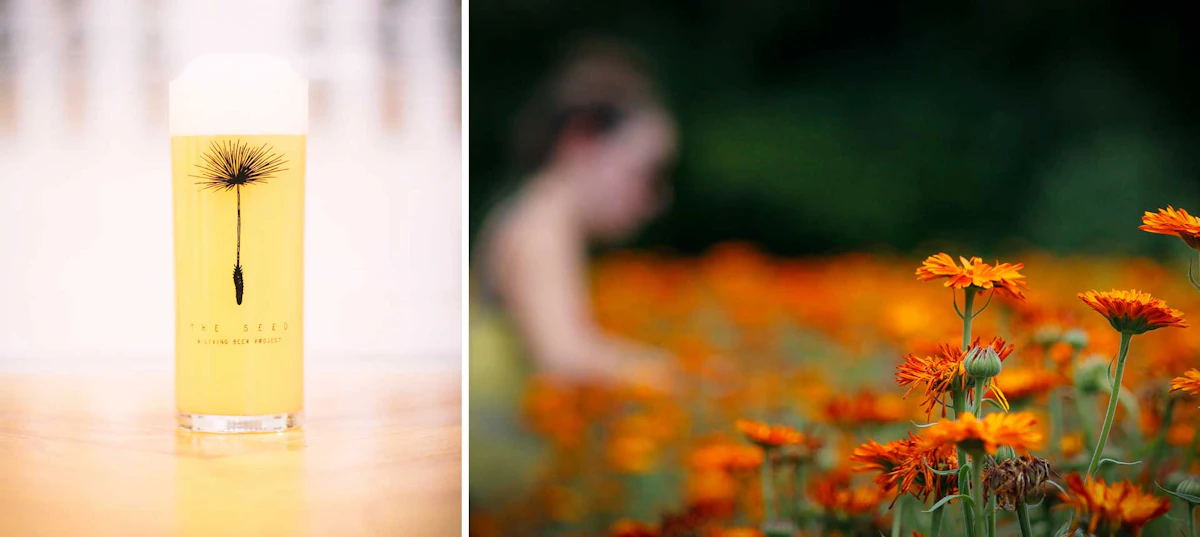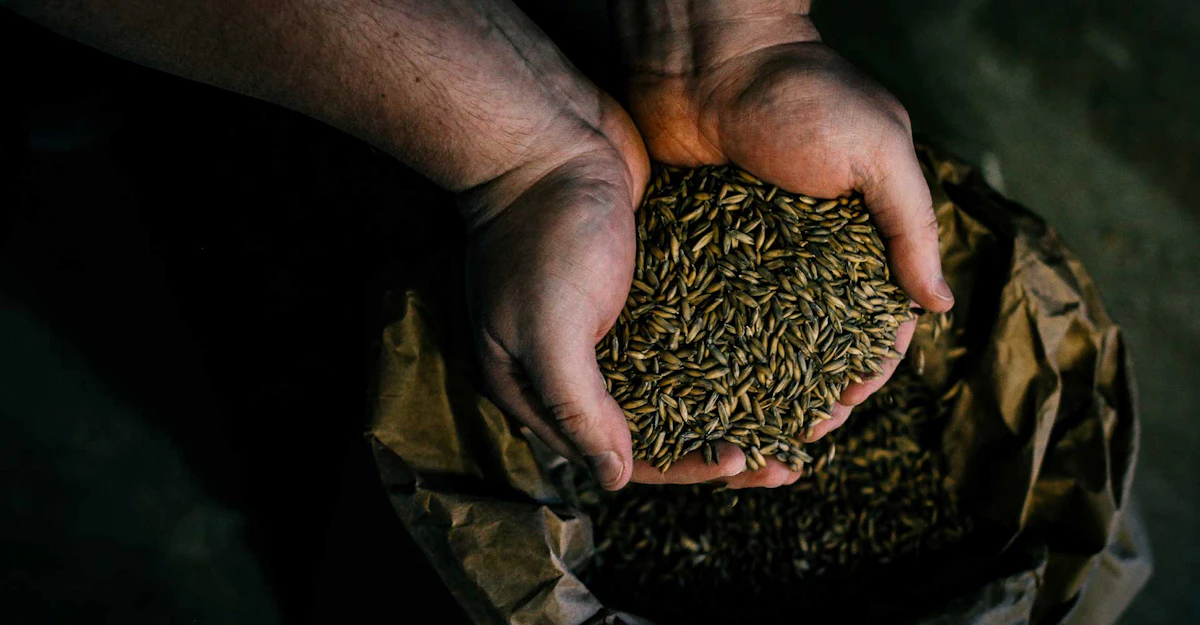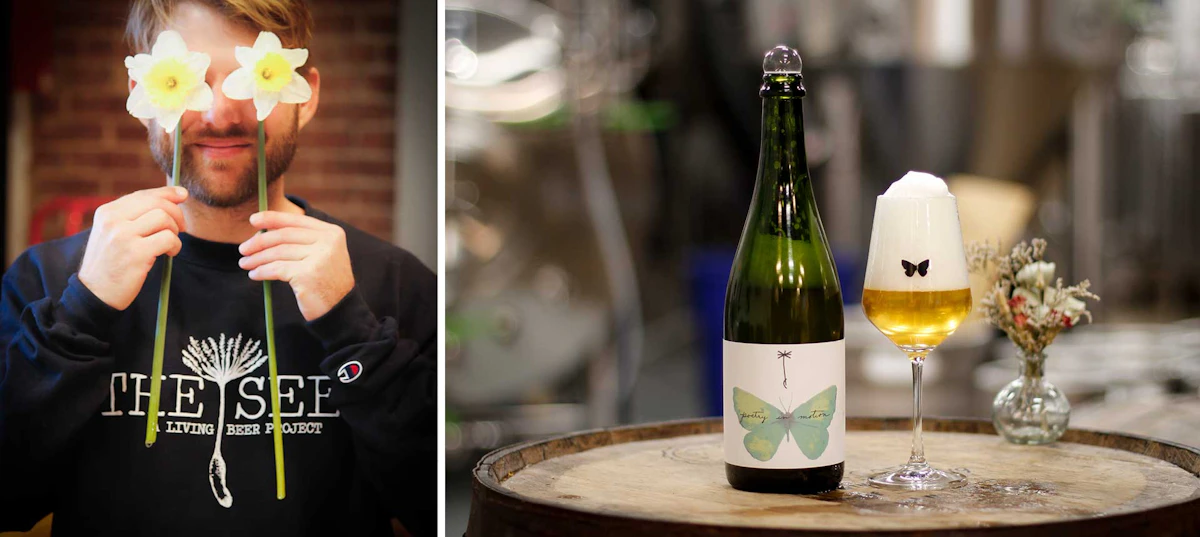Founded in 2020, the Seed is perhaps not what you’d expect to find in downtown Atlantic City, just 15 minutes’ walk from the Hard Rock’s giant guitar.
In contrast to the clanging casinos and bustling boardwalk, the Seed offers respite. Even the names of its beers are somehow relaxing: A Place to Rest, Stay Awhile, Unhurriedly, Quiet Fields, As Simple as Home?, and so on. It offers a refreshing downshift not only from the local action, but also from a craft segment drawn to extremes—whether that means pushing gravities as high as they can go or squeezing the most intense aroma out of the latest hop products.
A recent draft list offers a glimpse of what you might expect at the Seed. The first five of 10 beers on tap are all lagers—dark, rye, pale, light, and Italian-style. The next two are British-style and dark—mild and porter, the latter featuring chestnuts and cacao. Then we get into farmhouse flavors, with a mushroom saison and a bière de coupage—a mixed-culture blend.
Oh, and there’s one IPA.
“We make a variety of styles now,” says Amanda Cardinali, who cofounded the Seed with partner Sean Towers. “But I would say the true passion behind the entire project is saison.”
The Seed sold about 800 barrels of beer in 2024, and Cardinali says about 10 to 15 percent of that was saison—the word she uses for any of her mixed-culture creations, which often get fruit or other local botanicals and are always bottle- or keg-conditioned.
“It’s definitely a lower percentage than I would like of saison,” she says. “But that’s also keeping in mind that we don’t have a ton.” With about 30 oak barrels plus four stainless tanks in her mixed-culture program, there’s a limit to what she can produce—even if she could sell it all quickly. “It’s also just a tie-up of space. I think if we had more, I would fill more.”

Planting the Seed
Brewing was Cardinali’s first job after graduating from college in 2012. She and Towers had become obsessed with homebrewing and heard about a brewery—Tuckahoe—that had recently opened in nearby Ocean View, New Jersey.
“I was their first and only employee for a while,” she says. “So, I basically tried everything, but it was mostly brewing in the start, and working in the tasting room, and then packaging, more cellar tasks. And yeah, I just absolutely fell in love with it.”
Tuckahoe would eventually close, in late 2023, but a decade earlier its owners were giving Cardinali room to learn and explore her interests. Despite the tight space at Tuckahoe’s original location, Cardinali and Towers—a microbiologist—jumped at the chance to experiment with mixed-culture saisons and blends.
“They let us buy three oak barrels,” she says, “and they were like, yeah, we can do whatever we want with these three oak barrels. So that was super-exciting for us.” They put three different beers into those barrels, releasing the first one in 2015 as a mixed-culture saison with apricots. “That was very exciting and new and different,” she says. “So, we just fell even more in love with it.”
When Tuckahoe moved to bigger digs, the owners allowed Cardinali to add more barrels. “That just became my whole passion project,” she says. “But with these beers, obviously, you need to be super-patient, and it takes a long time. And I never really had the answers of when they’re going to be ready, when they’re going to be packaged. It’s just … the beer tells us when it’s ready. And, you know, sometimes that’s difficult to hear.”
Even when mixed-culture beers are a small percentage of a brewery’s output—as they usually are—they still cost money and time (which is money) and space (which is money). Meanwhile, “as time went on, I just started becoming a little more obsessed with that whole project, and I eventually realized that it’s going to be really difficult for me to do what I really want to do under someone else’s brand.”
With that in mind, Cardinali and Towers started thinking about opening their own space, “which is not anything that I ever wanted to do,” she says. “I was very content making wort and cleaning tanks and going home, without all the stress of it. But I think we just became so wrapped up. And saison and mixed-ferm—just the beautiful world of it—that didn’t really exist down here at all.” In New Jersey, at least, “no one was really making beer like that at that time.”
It took a while to pull it together. While Cardinali and Towers looked for investors and a space, Cardinali went to work at Ludlam Island Brewery in Ocean View—“with the caveat,” she says, “that I would be leaving soon to open up my own space.” She ended up staying there about three years. “I wasn’t brewing,” she says. “I was doing mostly cellar work and tasting room, which was amazing. It made me kind of free-fall in love with what I was doing.”
The Seed’s location, she says, “fell into our laps.” While visiting Atlantic City’s Little Water Distillery for a drink, they mentioned to the owner that they wanted to open a brewery. “Oh, that’s crazy,” he said, and he explained how his landlord had been holding a space next door for a brewery to take over. That deal was apparently falling through, however, so the landlord showed them the space.
“It was a pile of rubble,” Cardinali says. “And I was like, ‘This is it. This is our brewery.’” They hadn’t even been considering Atlantic City as a location. “But the minute I saw it, I was like, ‘Yep, this is the one.’ I think I love it—I mean, I wouldn’t trade it for anything. … Our original vision—and it’s still a vision that we have—would be on a farm, with access to all of our ingredients at our fingertips. But it’s super-special here.”
They started buildout in August 2019. Besides a few jobs for the electrician, HVAC tech, and plumber, Cardinali, Towers, and Towers’ parents did all the construction themselves. “We were jackhammering the floor,” Cardinali says. “We were pouring concrete, we were building the bar, building the walls—I’ve never painted so much in my entire life. So, it took a while.”
They installed a seven-barrel, indirect-fire brewhouse and HLT with a mash tun made from a converted dairy tank. “We’re milling into bags and then taking those bags to our tiny little brew deck, and graining in that way,” she says. “It’s definitely very hands-on. We don’t have any built-in pumps, no hard piping. It’s all cart pumps and soft hoses. And that’s how I learned. … It kind of forces you to be very one with the beer that you’re making.”
The Seed: A Living Beer Project started selling beer in October 2020—to-go cans only, amid the pandemic—finally opening its tasting room in February the following year.

A Living Passion Project
The beers in those 30 barrels plus a few stainless tanks are Cardinali’s threads for the weaving.
For example, that bière de coupage recently on tap is from the third batch of her Poetry in Motion—a blend of hop-forward, tank-fermented saison with Brett beer that fermented and matured in the barrels. That other saison on tap—called Ghosts Are All We Are, a collab with Odd Colony of Pensacola, Florida—fermented and matured in the barrels before conditioning on locally grown pioppino mushrooms.
While Cardinali and her team aim to keep at least one IPA on tap—and it’s usually the top seller, week to week—the lagers also sell well. Yet the saisons have their dedicated fans.
“I mean, definitely our other beer pays for this project,” she says. “But overall, I’m very happy with how people have been responding. I think there’s a very weird stigma around saison because they’re all so different—like, every saison is so different—and, you know, not all of them are to people’s tastes.”
In the taproom, she says, they often explain to customers that these are going to be different from what you’ve had before, and they’re also going to be different from each other. “We usually try to keep between two and three on tap, and even the two that are on tap are going to be wildly different.”
She doesn’t call them “sours,” and they won’t strip the enamel off your teeth. “Most of ours are not super-acid-forward, which I think helps, too. … We definitely try to keep ours very yeast-driven [but] with an acid component.”
Cardinali says they have a few regulars who started out as “IPA or bust.” However, visiting the Seed has turned them on to saison. “Now, they send me photos—they trade for, like, Hill Farmstead and Floodland,” she says. “I feel like a proud mom. I’m like, ‘Look at you!’… Just kind of watching the evolution of people trusting us is also really special.”

Beer of Its Place
Cardinali is New Jersey born and raised, and her saisons tend to be fiercely local in composition. Rabbit Hill Malt in Shiloh, New Jersey, about 50 miles west of the brewery, grows and malts all the grains. Fruits and other botanicals, when added—such as berries, spruce tips, honey, or flowers—are also local and seasonally driven. The Seed’s house culture, meanwhile, lives in those barrels, providing expressions that have evolved over time.
“At this point, they’re wildly different from even what we originally pitched in our barrels,” Cardinali says. “Some barrels, I don’t even think we ended up pitching [anything] into. We’re not super-strict on our SOPs [for] our equipment on that side of the brewery. So, if we’re transferring a barrel and then transferring another barrel, most likely we’re not really giving it a thorough clean in between. So, everything’s more cohesive at this point.”
In the early days of their experiments, Towers would isolate cultures from any beers they enjoyed. “At one point, I think our refrigerator had an entire shelf dedicated to small vials of yeast and bacteria and … dregs of bottles that we liked, or just cultures that we liked,” Cardinali says. “So, at this point, I don’t even know—I mean, they’re all written down. … But I would say they’ve also just evolved and come a long way from when we first started filling the barrels. But it’s been a really fun evolution, and now we’re getting to know our barrels.”
Those barrels have their own personalities, too. “We know that these barrels usually lean more acid-forward, and these are usually a little gentler, and these usually need maybe some blending.”
And she takes advantage of those threads to maintain the variety, which then helps to maintain the interest among customers. “If you come here normally, and we have two saisons on—in my perfect world—I try to keep one that’s a little more classic, and then one that is either dry-hopped or fruited,” she says. “We try to keep both different enough that maybe—if you are into it or willing to try it—you try both.”
There isn’t always a set plan for how to combine those threads—and if there is, it can change. “I try to schedule—once a month, if I’m lucky—just a day where I literally write on the calendar, ‘Saison Things.’ It usually means, ‘All right, we’re going to sit down, we’re going to pull nails. We’re going to go through, we’re going to take notes—we’re going to try to map out the next few barrels that are tasting good.”
It doesn’t all end up in blends. An occasional series called Replete Trees usually comes from a single barrel, unblended.
“It depends on the barrel,” she says. “We normally go into a barrel tasting just completely open-minded—like, these could all be blends, none of these could be blends—it’s whatever the barrel is telling us.”

Left: Cardinali and her dog, Brett
Branching Out
Initially, the Seed sold beer out of its taproom only. It later added a few New Jersey accounts, gradually growing into a few more in Pennsylvania and New York. Since December, they now have a full-time salesperson focused on New Jersey.
Because the IPA is usually the taproom’s top seller, they always try to have at least one or two on tap. “There are times where we have multiple, there are times where we have none,” she says. “I try to avoid the none because it makes people very upset. But it’s also a good opportunity.”
In the Seed’s early days, if they would run out of IPA, Cardinali says she would apologize profusely to her staff. “I’m like, ‘I don’t know what kind of reaction you’re going to get from this, and I’m really sorry in advance.’ And now they look forward to it because it forces people to step out of their comfort zone and try something different.” That “something different” might be their dark lager, As Simple as Shadows?—it’s a staff favorite, she says, “so I’m sure they also push it.”
Besides Cardinali, there are three full-time staff: brewers Chris Howells and Brandon Almand, plus an operations manager who oversees taproom and sales. The number of part-timers can vary widely by season; Atlantic City gets a tourist flow that swells all summer and especially on weekends. That ebb and flow also affect their local accounts, which buy far fewer kegs in the winter.
“It’s very dependent on the weekend and what concerts are happening and what’s going on in the city,” she says. “And just trying to keep our finger on the pulse of that has been kind of fun and sometimes challenging.”
Early on, she says, most of the customers they asked said they were from New York or Philadelphia. “New Jersey maybe didn’t really know that we existed—and maybe still doesn’t really know we exist, just because we haven’t had a distro model and because we do kind of weird things for our state,” she says.
“But I think everyone’s kind of shifting a little bit of what they’re brewing, and what people are drinking. So, I think it’s hopefully a good time for us.”
One thing shifting over the past few years, for example, is people drinking more craft lager—a brewer-driven trend, as customers often appreciate that it’s what the brewer wants to drink. There may be a lesson there for brewers who love farmhouse-inspired, mixed-culture beers.
But even if drinkers don’t shift that way, Cardinali says, that won’t stop her from leaning into her passion project.
“That’s my obsession,” she says. “There was no part of me that was going to give that up. It’s literally why we opened a brewery. I think people are starting to pick up on our love of it, and I think that’s what makes them excited.”
To communicate that enthusiasm to customers, she says, it’s important to tell them the story of each beer. “We always describe it as if we’re capturing these moments in time,” she says. “We’re capturing the peaches from last August. We’re capturing the dandelions that were the first ones to pop up after winter. And that to us is so special, and I think we try really hard to convey that. … Because they’re like, ‘Oh, these people are so excited about this weed that they picked from this field that they put in a beer. I feel like I should try it.’ … If you really love it and you’re super-passionate about it, I think people pick up on that.”
They also make it a point to openly celebrate saisons—for example, on Saison Day, once per year, when the Seed might put as many as eight of them on tap.
“I don’t know; it’s still very dreamy to me, I guess,” Cardinali says. “So, maybe I’m still living in a little bit of a fantasy land. But I think I’m okay with that.”
